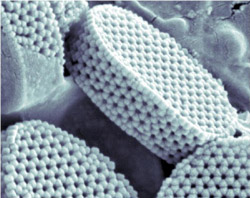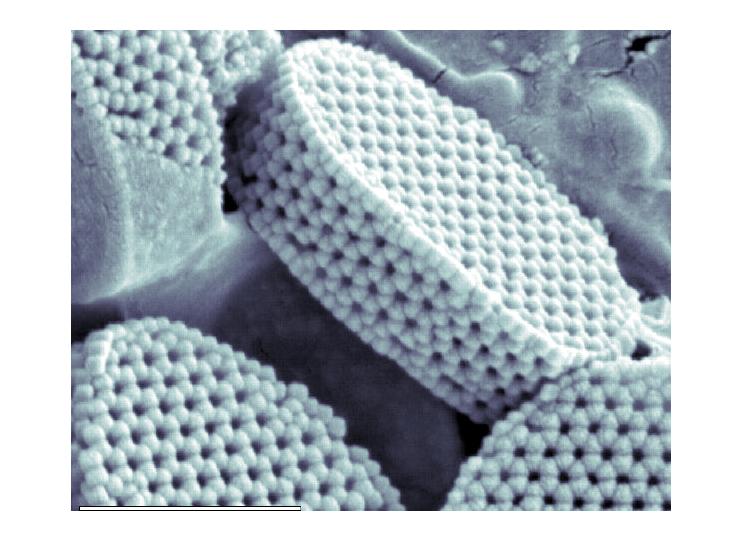Ingenious Algae
Many of the oceans’ algae have evolved natural “sunscreens” as protection from the sun’s ultraviolet rays. But in the September Physical Review E, researchers show that geometrical arrangements of tiny calcite crystals surrounding certain algae achieve the same effect as chemical sunscreens, reflecting ultraviolet radiation while allowing longer wavelengths through for photosynthesis. This natural “photonic” device parallels similarly ordered structures that generate the colored patterns of butterfly wings and may lead to new designs for technological devices that manipulate light.
Coccolithophores are single-celled algae. Each cell is encased in a shell made of periodically spaced calcite crystals, a structure that looks something like a microscopic piece of macramé. The shells reflect sunlight, and blooms of these algae color the water. They reflect light more efficiently toward the ultraviolet end of the spectrum, although it has been difficult to get precise data in the natural environment. Some biologists have speculated that reflecting UV might benefit the organism, but no one has studied the precise function and properties of the coccolithophore shell.
To understand better how these structures reflect light, Rafael Quintero-Torres of the National Autonomous University of Mexico and his colleagues modeled a shell’s disk-like face as a two-layered structure: The bottom layer contains spherical reflectors in a “honeycomb” arrangement of hexagons, while in the top layer the spheres form a sparser pattern of triangles. The team approximated the microcrystals as spheres because, at 90 nanometers across, they are too small for the relevant wavelengths of light to “notice” the box-like shape they take on in some coccolithophore species.
The combined effect of light reflecting from each sphere determines the reflectivity of the whole structure. As with all wave “addition,” different light waves reflected within the structure can enhance or partially cancel one another, depending on how their peaks and troughs line up, which in turn depends on the wavelength. The researchers found that the double layer becomes sharply more reflective for wavelengths less than about 400 nanometers. Longer wavelength light–in the visible range the cell uses for photosynthesis–is more easily transmitted. The team’s calculations yielded similar spectra for light hitting the surface at any angle and with different polarizations. UV reflection at all angles is important for survival, says Quintero-Torres, because algae in the oceans have all possible orientations.
The researchers also calculated the reflectivity of spherical crystals placed randomly within the same overall volume as the disk-like face. The disordered arrangement showed a slight tendency to reflect visible wavelengths more efficiently than ultraviolet. This dramatic difference confirms that interference among reflections from the ordered arrangement of spheres is critical to the high ultraviolet reflectivity, according to the team.
“This is a nice paper,” says zoologist Andrew Parker of the University of Oxford, England, who agrees that it makes a good case for coccolithophores protecting themselves against ultraviolet damage by physical rather than chemical means.
Biological designs such as this also hold lessons for applied physicists, says Quintero-Torres. Researchers have been developing so-called photonic crystals, highly ordered microstructures that have tailor-made reflecting and transmitting properties. Such devices can in principle manipulate light signals just as silicon chips manipulate electronic signals. In looking for new ways to design photonic crystals, says Quintero-Torres, “we can learn from nature how to solve problems.”
–David Lindley
David Lindley is a freelance science writer in Alexandria, Virginia.





